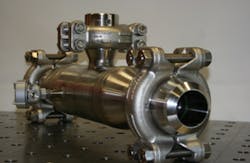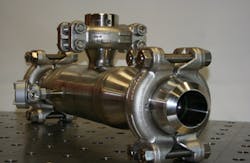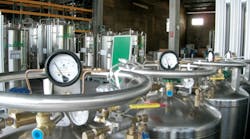Differential-pressure (DP) flowmeters are composed of two elements—a pressure transmitter and a primary element. The primary element places a constriction in the flowstream and creates a pressure drop that makes DP flow measurement possible. The DP transmitter uses the upstream and downstream pressure values, together with Bernoulli’s theorem, to compute flowrate. There are many types of primary elements, including orifice plates, Venturi tubes, flow nozzles, Pitot tubes, wedge elements, and laminar flow elements. There is a large number of companies that only produce primary elements. They often leave it up to the customer to decide what kind of DP transmitter will be used with the primary element.
DP flowmeters have a huge advantage in installed base, and end-users are in many cases staying with DP flow technology. End-users are likely to change technology only if their measurement requirements change in a way that calls for a different technology, or if they have a problem with their existing technology. Many DP flow installations have been in place for many years and are operating without difficulty. If accuracy requirements change, however, this could prompt a switch to a new flow technology.
Pressure transmitter suppliers have also introduced many product improvements, including greater accuracy and stability, which enable end-users to upgrade their technology without abandoning DP technology. One important advance is enhanced accuracy levels in pressure transmitters, including DP transmitters. Other options include multivariable flowmeters or integrated flowmeters that contain both a DP flow transmitter and a primary element. In addition, suppliers have upgraded their Fieldbus and other communication protocol options to give end-users wide latitude in their communication options. All these options allow customers to stay with DP flow while opting for more technologically advanced products.
READ ALSO:
- Energy and Large-Pipe Applications Drive Coriolis Technology to New Heights
- Magmeters Top the Flowmeter Market In Revenue
- PD Flowmeters Poised to Gain from Oil & Gas Application Opportunities
- Emissions Monitoring Applications Propel Thermal Flowmeter Market
- Turbine Flowmeters Remain Competitive in Turbulent Market
- Custody-Transfer Applications Drive Ultrasonic Flowmeter Growth
- Vortex Flowmeters Prove Their Worth In Steam Flow Measurement
Some new options are available on the primary elements end in addition to the transmitter end, such as improved orifice plates, a product that combines a nozzle with an averaging Pitot tube, and the V-Cone. While the technology improvements to primary elements have been moving at a slower pace than the improvements to transmitters, expect more work to be done in this area over the next several years. Truly imaginative work in the primary elements area could have a significant impact on the popularity of DP flowmeters.
Bristol Babcock (now part of Emerson) introduced the first multivariable pressure transmitters in 1992. Since that time, other companies have followed suit, including Honeywell (www.honeywellprocess.com), Emerson Rosemount, and Yokogawa (www.yokogawa.com). Multivariable transmitters measure more than one process variable in a single instrument. Typically, these transmitters measure pressure, differential pressure, and temperature. In some cases, they use these values to produce a mass flow measurement.
Multivariable transmitters can eliminate the need to buy a separate flow computer to perform the flow calculation. The trend toward multivariable transmitters can be expected to continue in the DP transmitter and flowmeter markets. These products typically sell for less than it would cost to buy the transmitters separately, with an average price in the $2,000 range. In addition to offering a more economical way to measure flow, multivariable transmitters can measure both mass and volumetric flow, making them useful for measuring steam, gas and liquids.
To read more about Flow Research’s work in the area of DP flow measurement, visit www.flowdp.com.



